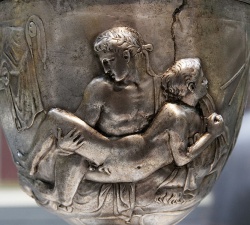Ancient Rome
This article is a fledgling. Help BoyWiki grow by expanding it |

Unlike the Greeks, Romans never institutionalized pederasty. [1] Homosexual behaviors in Rome were acceptable only within an inherently unequal relationship; male Roman citizens retained their masculinity as long as they took the active, penetrating role, and the appropriate male sexual partner was a prostitute or slave, who would nearly always be non-Roman.[2] Man-boy relationships were driven primarily by lustful sex, and there was no educating or civil pursuit involved. Furthermore, whereas the Greek erastes was charged with protecting the young eromenos, no such obligation existed in Rome.[3] Roman boylove though influenced by the Greeks slaves brought to Rome often was as violent and brutal as the Romans themselves. The Romans tended to value sexual conquest above romance and love. However that is not to say that Roman men never fell in love with boys which of course they did and sometimes formed lifelong relationships. Pederasty came in and out of fashion during different periods of both the republic and the empire. Roman patricians frequently condemned the practice of Greek love publicly while privately complaining that “a pretty boy cost more than a plot of land ….” [4] Many politicians and other affluent and influential Romans often kept young slave boys as lovers. Much romantic poetry written by older men to the boys who they loved or who's beauty they admired last to this day from around the time of Augustus [5]
Elite Romans often kept a puer delicatus ("exquisite boy") as a form of high-status sexual consumption (status symbol), a practice that continued well into the Imperial era. The puer delicatus was a slave chosen from the pages who served in a high-ranking household. He was selected for his good looks and grace to serve at his master's side, where he is often depicted in art. Among his duties, at a convivium (Roman drinking party equivalent of the Greek Symposium) he would enact the role of Ganymede, the Trojan youth taken by Zeus to serve as a divine cupbearer.[6] Attacks on emperors such as Nero and Elagabalus, whose young male partners accompanied them in public for official ceremonies, criticized the perceived "Greekness" of male-male sexuality.[7] Though the Romans viewed Greek love, or the cultural model of Greek pederasty with a certain romanticism and were mostly tolerant of the practice, it continued to be viewed as foreign and exotic or not quite the Roman way by the general public.
Roman Law
Roman Law as described in theLex Scantinia mainly regulated the sexuality of freeborn men and boys. They considered those who took the passive position in sexual intercourse as unmanly. Homosexual behaviors at Rome were acceptable only within an inherently unequal relationship; male Roman citizens retained their masculinity as long as they took the active, penetrating role, and the appropriate male sexual partner was a prostitute or slave, who would nearly always be non-Roman.[8]
References
- ↑ Percy, William A. Pederasty and Pedagogy in Archaic Greece. University of Illinois Press, 1996. CHAPTER VI ISBN 0252067401
- ↑ Helen King, "Sowing the Field: Greek and Roman Sexology," in Sexual Knowledge, Sexual Science: The History of Attitudes to Sexuality (Cambridge University Press, 1994), p. 30.
- ↑ http://www.thinkaboutit-knowaboutit.com/2013/03/an-objective-history-of-pederasty.html
- ↑ Polybius (31.25)
- ↑ http://www.matthewnederlanden.com/bible-commentary/jesus-heals-the-centurion-matthew-8.php
- ↑ Pollini, "Warren Cup," p. 34.
- ↑ Caroline Vout, Power and Eroticism in Imperial Rome (Cambridge University Press, 2007), p. 136ff.
- ↑ Helen King, "Sowing the Field: Greek and Roman Sexology," in Sexual Knowledge, Sexual Science: The History of Attitudes to Sexuality (Cambridge University Press, 1994), p. 30.